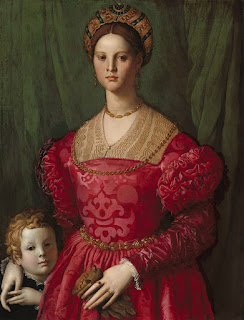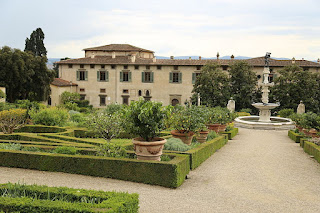Grand Duke grief stricken after death of clever child
Maria de’ Medici, the beautiful eldest child of Cosimo I de’ Medici was born on this day in 1540 in Florence. The apple of her father’s eye, she was one of the brightest of the Grand Duke of Tuscany’s children, but she was destined to lead a very short life.
A portrait, possibly of Maria de' Medici,
by the Florentine painter Bronzino
Maria was the daughter of Cosimo I and Eleonora di Toledo and was Cosimo’s first legitimate child. He had fathered an illegitimate daughter, Bia de’ Medici before his marriage to Eleonora but she had died young.
Maria was educated with her brothers and was reputed to have been so clever that when her brother, Francesco, didn’t understand his Greek lesson, his tutors would ask Maria to explain it to him.
She grew up to be an elegant, highly educated and decorous young woman according to contemporary accounts and a marriage was arranged for her with Alfonso II, Duke of Ferrara. However, Maria died unexpectedly in November 1557 at the age of 17.
Maria’s death occurred while she was staying in the port of Livorno and the most likely cause is thought to have been that she contracted malaria.
However, another cause for her death is suggested in a book called The Tragedies of the Medici by Edgcumbe Staley. The book recounts that Maria was so lovely she was kept closely guarded from men, but that she somehow managed to meet a young man, Malatesta de’ Malatesti in secret and they became lovers.
 |
| Maria's father, Cosimo I de' Medici, also depicted by Bronzino |
Other accounts say that Cosimo was devastated by Maria’s death and that he mourned for his daughter deeply and kept her portrait in his bedroom until the day he died.
Maria’s younger sister, Lucrezia di Cosimo de’ Medici, later married Alfonso II.
Cosimo I, whose line was descended from Lorenzo de' Medici the Elder, brother of the dynasty's recognised founder, Cosimo the Elder, was the second Duke of Florence and first Grand Duke of Tuscany. He was both a shrewd and unscrupulous leader, bringing Florence under his despotic control and increasing its territories.
The first to have the idea of uniting all public services in a single building, it was Cosimo I who commissioned the Uffizi, which meant Offices, a beautiful building that is now an art gallery in the centre of Florence.
In a programme of improvements in the city, he had the interior of Palazzo Vecchio redecorated and adopted the Pitti Palace as his residence, overseeing the design of the Boboli Gardens. He also had the gallery over the Ponte Vecchio built to enable him to move from one palace to the other easily.
Travel tip:The Villa Castello is famed for its beautiful
gardens, which attract thousands of visitors
It is quite likely that Maria de’ Medici was born at Villa Castello, the Medici residence near the town of Sesto Fiorentino, at the foot of the hills northwest of Florence. Cosimo I inherited the house from his father Ludovico de’ Medici - better known as the condottiero, Giovanni dalle Bande Nere - and spent much of his time there after securing his position as ruler following the assassination of the incumbent Duke of Florence, Alessandro de' Medici, in 1537. Cosimo did much to improve the villa, commissioning the engineer Piero da San Casciano to construct a system of aqueducts to bring water to the villa and its gardens, the sculptor Niccolò Tribolo to create fountains, statues and a garden, and the architect Giorgio Vasari to restore and enlarge the villa, which at one time housed some of the great art treasures of Florence, including Sandro Botticelli's Renaissance masterpieces The Birth of Venus and Primavera.
Travel tip:
Livorno's canal district has become known as Venezia
Nuova, an area famed for its night life
The port of Livorno, where Maria de’ Medici was thought to have been when she suffered a fatal exposure to malaria, is the second largest city in Tuscany after Florence yet is often overlooked by visitors, many of whom arrive by cruise ship and travel on to Florence, Siena or other destinations. Yet Livorno has plenty to recommend it as a destination in itself. Built during the Renaissance with Medici money as an “ideal town”, it became an important free port, and until the middle of the 19th century was one of the most multicultural cities in Italy thanks to an influx of residents from all round the world who arrived on foreign trading ships. Visitors to Livorno today can sample some of Italy’s best seafood restaurants, enjoy the elegance of the Terrazza Mascagni on the waterfront and the quirky charms of Venezia Nuova, a former commercial district criss-crossed with canals.
Also on this day:
1639: The birth of musician Alessandro Stradella
1881: The birth of politician Alcide De Gasperi
1895: The birth of composer Mario Castelnuovo-Tedesco
1899: The birth of supercentenarian Maria Redaelli






.png)
.jpg)

.jpg)
.jpg)

.jpg)
